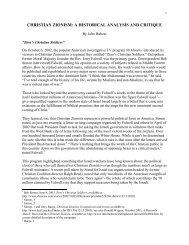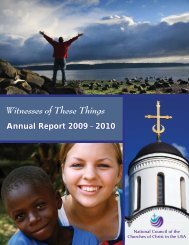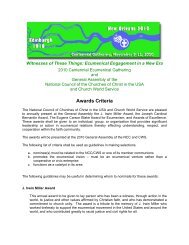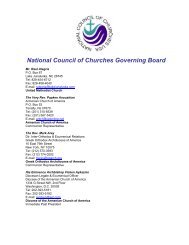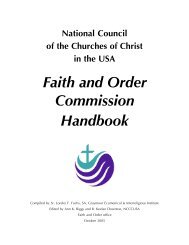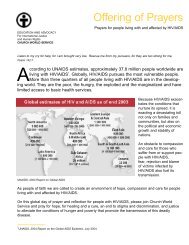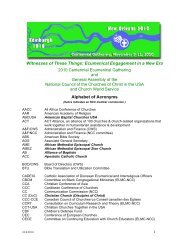Common Agreement on Mutual Recognition of Baptism - National ...
Common Agreement on Mutual Recognition of Baptism - National ...
Common Agreement on Mutual Recognition of Baptism - National ...
You also want an ePaper? Increase the reach of your titles
YUMPU automatically turns print PDFs into web optimized ePapers that Google loves.
364<br />
365<br />
366<br />
367<br />
368<br />
369<br />
370<br />
371<br />
372<br />
373<br />
374<br />
375<br />
376<br />
377<br />
378<br />
379<br />
380<br />
381<br />
382<br />
383<br />
384<br />
385<br />
386<br />
387<br />
388<br />
389<br />
390<br />
391<br />
392<br />
393<br />
394<br />
395<br />
396<br />
397<br />
398<br />
399<br />
400<br />
401<br />
402<br />
403<br />
404<br />
405<br />
406<br />
407<br />
408<br />
Sacramentality c<strong>on</strong>sists <strong>of</strong> the coalescence <strong>of</strong> divine and human elements in the life <strong>of</strong> the<br />
Church whereby God acts through the visible organs <strong>of</strong> the Church especially the sacraments.<br />
Catholics, therefore, speak <strong>of</strong> the Church analogously as a sacrament, in that the ―Church, then,<br />
both c<strong>on</strong>tains and communicates the invisible grace she signifies‖ (CCC 774). In Christ the<br />
Church is ―a sign and instrument both <strong>of</strong> a closely knit uni<strong>on</strong> with God and <strong>of</strong> the unity <strong>of</strong> the<br />
whole human race‖ (Lumen Gentium 1).<br />
Sacramentality is c<strong>on</strong>sistent with the doctrine <strong>of</strong> creati<strong>on</strong> whereby God speaks through<br />
the visible creati<strong>on</strong> making it possible for human intelligence to read traces <strong>of</strong> the Creator in the<br />
material cosmos (CCC 1147). A solid theological anthropology needs underscore the social<br />
being <strong>of</strong> humanity and how signs and symbols are intrinsic to communicati<strong>on</strong> through language,<br />
gestures, and acti<strong>on</strong>s (CCC 1146). They are the means for ―expressing the acti<strong>on</strong> <strong>of</strong> God who<br />
sanctifies men, and the acti<strong>on</strong> <strong>of</strong> men who <strong>of</strong>fer worship to God‖ (CCC 1148). C<strong>on</strong>sistent with<br />
God‘s covenant with Israel, wherein both cosmic and social symbols are taken up in Israel‘s<br />
liturgical life, Jesus himself <strong>of</strong>ten illustrated his preaching with physical signs and symbolic<br />
gestures, e.g., the use <strong>of</strong> spittle to heal the blind man (Jn 9: 6). So too, since Pentecost, ―the Holy<br />
Spirit carries <strong>on</strong> the work <strong>of</strong> sanctificati<strong>on</strong>‖ through the sacramental signs <strong>of</strong> the Church (CCC<br />
1152), what has been called its ―sacramental ec<strong>on</strong>omy‖ or ―dispensati<strong>on</strong>‖ (CCC 1076).<br />
ii. A Reformed View<br />
From within the l<strong>on</strong>g-standing Western traditi<strong>on</strong> where sacrament referred both to the<br />
church, which is the body <strong>of</strong> Christ, and to the sacraments c<strong>on</strong>stituting the church, the Reformed<br />
traditi<strong>on</strong> asserts that the true church, invisible to human eyes but visible to God‘s eyes, is<br />
comprised <strong>of</strong> God‘s faithful people gathered as the body <strong>of</strong> Christ. So The Westminster<br />
C<strong>on</strong>fessi<strong>on</strong> (IX.4) says, ―By the indwelling <strong>of</strong> the Holy Spirit all believers being vitally united to<br />
Christ, who is the Head, are thus united <strong>on</strong>e to another in the Church, which is his body (cf.,<br />
Larger Catechism, Qq. 64-66; Scots C<strong>on</strong>fessi<strong>on</strong> XVI; Sec<strong>on</strong>d Helvetic C<strong>on</strong>fessi<strong>on</strong> XVII).<br />
Reformed theology calls neither the visible nor the invisible church a sacrament.<br />
Reformed theology applies the word ―sacrament‖ to the two divinely instituted signs,<br />
baptism and Lord‘s Supper, to which God attaches the promise <strong>of</strong> grace (e.g., Scots C<strong>on</strong>fessi<strong>on</strong><br />
XXI; Heidelberg Catechism Q. 68; Sec<strong>on</strong>d Helvetic C<strong>on</strong>fessi<strong>on</strong> XIX; Belgic C<strong>on</strong>fessi<strong>on</strong>, art. 34;<br />
Westminster C<strong>on</strong>fessi<strong>on</strong> XXVII). In a loose sense, the true visible church might be called<br />
―sacramental‖ because its two marks, the preaching <strong>of</strong> the gospel and the right administrati<strong>on</strong> <strong>of</strong><br />
the sacraments, both communicate God‘s real self-giving in Jesus Christ, but such language<br />
would be historically foreign to the Reformed traditi<strong>on</strong>. Likewise, although some church rites,<br />
such as ordinati<strong>on</strong>, penance, and marriage are God-given and useful (Sec<strong>on</strong>d Helvetic C<strong>on</strong>fessi<strong>on</strong><br />
XIX); and although some simple church rites that are not c<strong>on</strong>trary to the Word <strong>of</strong> God might be<br />
useful cerem<strong>on</strong>ies (Sec<strong>on</strong>d Helvetic C<strong>on</strong>fessi<strong>on</strong> XXVII); the Reformed traditi<strong>on</strong> has never<br />
c<strong>on</strong>sidered such rituals to be ―sacramentals,‖ in the way that the sign <strong>of</strong> the cross, palms, ashes,<br />
incense, or candles were a means <strong>of</strong> grace within the medieval church.<br />
By c<strong>on</strong>trast, the Reformed traditi<strong>on</strong> has c<strong>on</strong>sidered the created order to be ―sacramental,‖<br />
ins<strong>of</strong>ar as the word c<strong>on</strong>notes God‘s self-communicati<strong>on</strong>, even if Reformed theology typically has<br />
refrained from such language. For example, Calvin believed that God accommodates God‘s self<br />
in order that we might know who God is. God desires to span the distance between Creator and<br />
creati<strong>on</strong> and meets us where we are, communicating to us as we so need, because we otherwise<br />
are incapable <strong>of</strong> knowing God (e.g., Com. Ex. 3:2; Com. Rom. 1:19; Com. 1 Cor. 2:7). The<br />
10



